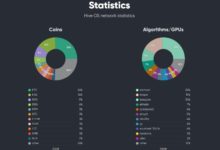Crypto and Bitcoin Miners Rebrand and Diversify to Survive: A Look at Their New Strategies.

Bitcoin miners are trying to survive an icy crypto winter by broadening the scope of their business, both in name and in practice.
On Jan. 4, one of the biggest publicly traded bitcoin mining firms announced that it was swapping the “Blockchain” out of its name for “Platforms.» The rebranding to Riot Platforms (RIOT) was to “underpin” an “increasingly diversified business.”
This article is part of CoinDesk’s “BUIDL Week.”
It is not the only firm making a name change. In the past year, miners have worked to diversify their revenue streams into other products and services using energy-intensive data centers. Some did so in response to brutal market conditions while others took steps to prepare for a downturn when business was still going strong.
The strategy is the opposite of what we’ve seen in past bull markets, where publicly traded firms would add the word “crypto” or “blockchain” to their names and see their shares surge more than 100% in a day – even if the company had no viable crypto-related business plan.
Now, “There’s a general desire by companies to distance themselves from the crypto bubble of the last couple years,” said D.A. Davidson analyst Chris Brendler. “It makes it easier when you’re dealing with more traditional finance institutions.”
Exactly how much of this wave of corporate rebranding and promises of new business lines is just talk to pump stock valuations in a depressed market, and whether it will last, is yet to be determined. It depends on how profitable it will be to diversify.
“As we saw in the last bear market, many miners are pivoting their public narratives as a diversified business so that they don’t face solely the struggling mining valuations,” said Ethan Vera, chief operating officer of mining services firm Luxor Technologies.
Finite revenue from bitcoin mining
Just like traditional commodities, bitcoin mining is an extremely competitive and capital-intensive business, with miners competing for an asset that is limited in quantity.
There are only about 2 million more bitcoins that can be mined until the Bitcoin network reaches a cap of 21 million. Assuming the current bitcoin price of $25,000 per token, the total value of bitcoin to be mined works out to about $50 billion. That amount is “super finite,” said Lucas Pipes, an analyst at investment bank B. Riley Financial.
With many miners adding constant computing power to mine the limited amount of bitcoin, basing a whole business model on mining alone may not be viable. So companies are looking to repurpose some of their computing power for other industries and services. This includes selling “high-performance computing” to firms in industries like artificial intelligence and cybersecurity.
Others are looking to capitalize on energy markets, either by owning their own assets or selling energy back to the grid.
“If you want to have a market cap of $50 billion – and what good CEO doesn’t want to have a [high] market cap…you need to do something else as well,” Pipes said.
See also: What Will It Take for Bitcoin Mining Companies to Survive in 2023
However, many strategies miners are implementing to diversify could do more harm than good. High-performance computing services take away from their core business, according to D.A. Davison’s Brendler.
Pipes thinks miners are probably better off just focusing on mining bitcoin, instead of entering a new sector and taking on clients that need high-powered computing and compete against established tech firms such as Amazon and Microsoft. And what about miners trying to sell energy to the grid? That’s just another “sign of the [difficult] times,” said Brendler.
The energy play
One of the ways miners are diversifying their revenue is by leveraging their high energy consumption and close ties to power grids.
Riot, for instance, acquired an electrical engineering company last year to service its mega-mine in Texas called Whinstone. It’s now offering similar services to other companies. Though gross margins from this new business (around 10%) were far shorter than its mining operations (about 59%, before applying power credits) for the first nine months of 2022, it could be an area of growth before including power credits, according to the company’s third-quarter earnings report.
Meanwhile, Riot also gained $21.3 million in power credits in nine months ending Sept. 30 by shutting down its operations to redirect energy back to the Texas grid, according to its third-quarter report.
The strategy is not an attempt to pivot away from its mining business, but to gain more control over costs and turn them into a revenue stream, Riot CEO Jason Les said. “We have a vertically integrated strategy for our bitcoin mining focus, and with that strategy we are focused on taking more control of our inputs and turning expenses into revenues.”
Competitors Greenidge Generation (GREE) and Stronghold Digital Mining (SDIG) also own fossil fuel-based power generators and sell power back to the grid.
However, both firms saw their gross margins for their power segments dramatically decrease through 2022, well into negative territory. Greenidge ended the third quarter with a gross margin of -4%, whereas Stronghold ended with -72% when including maintenance costs, according to data by The MinerMag Head of Research Wolfie Zhao.
See also: Bitcoin Mining: A Positive or Negative Indicator for the Future of Crypto
Greenidge’s support services segment, which offers “customer service, sales support and technical support,” has proved the most profitable, with a gross margin over 50% versus mining margin of about 42%, according to the firm’s quarterly report.
The high-performance computing play
Miners entering the high-performance computing market are essentially hitching the wagon on a “mega-trend that should last for many years,” B. Riley’s Pipe said.
Bitcoin miners are uniquely positioned to compete in high-performance computing as most of them already have data centers and have access to low-cost power, said Luxor’s Vera.
However, the high-performance computing market is very competitive and miners lack the infrastructure and capabilities of already established data center operators. The computing industry is “a business geared to face customers,” Vera said, and many bitcoin miners don’t exactly have sales divisions.
In early 2022, Canadian mining company Hut 8 Mining (HUT) bought five data centers from TeraGo for about $22 million, which had grown to 14% of its revenue by the end of the third quarter. That’s more than its mining hosting business was bringing in quarterly last year.
Read more: Hut 8’s Data Center Deal Will Set It Apart From Peers, Analyst Says
Diversifying into the wider world of “compute” is essentially catching a “rising tide” B. Riley’s Pipe said. The industry may ebb and flow, and it might be riskier depending on the clientele, but overall it’s a growing sector.
Zhao estimates that gross margin for Hut 8’s high-performance computing segment has remained around 50% through 2022, while its mining margin dropped to 34% in Q3. For comparison, operating margins for major computing firms such as Amazon Web Services and Microsoft are reportedly in the 25%-40% range.
See also: Shares of Bitcoin Miner Hut 8 Slump on Merger With US Bitcoin Corp.
Time for a blockchain rebrand
Similar to Riot, Applied Digital Corporation (APLD) dropped the “blockchain” from its name. This was “to distinguish that its next-generation data centers support many other high-performance computing applications as well,” said its press release at the time.
The firm has yet to bring in revenue from high-performance computing applications but targets 10% of gross revenue by the end of 2023 from that segment, CEO Wes Cummins told CoinDesk. The gross margin for high-performance computing is higher than mining, Cummins said.
For now, APLD hosts 128 graphics processing units (GPU) “retrofitted portion of an existing building in Jamestown [North Dakota] for Web3 applications,” and has plans to pilot hosting another 300 GPUs for machine learning in the first quarter of 2023. The 300 GPUs will be in a 5 megawatt (MW) facility dedicated to GPUs that broke ground in December 2022.
These contracts are tiny compared to the 185 MW of long-term crypto mining hosting contracts the firm had signed as of October, or the 276 MW it has signed to host for Marathon Digital Holdings (MARA), or the 100 MW “dedicated blockchain power facility” it runs in Jamestown.
Canadian miner Hive Blockchain (HIVE) has been preparing to launch cloud services for high-performance computing since the Ethereum Merge effectively dismantled its Ether mining business. The Merge upgraded the blockchain’s proof-of-work backbone in favor of a less intensive proof-of-stake algorithm.
The cloud offering is 25 times more profitable than mining, when measured in dollars per electricity consumption, given current market conditions, has an annual revenue of $1 million on a run-rate basis, the company said on Tuesday. Hive has a fleet of 38,000 GPUs and is currently using 450 of those for its cloud proof of concept, which consume about 80 kilowatts (KW) to make $3,500 per day.
See also: Bitcoin Miners Need Ethereum As Well | Opinion
Hive has also deployed some of these GPUs to mine other coins, which it later converts into bitcoin. In January, only 6% of Hive’s computing power came from alt-coin mining, as its GPU fleet was curtailed to sell energy back to the grid, which totalled $180,000 for the month. In the quarter prior to the Merge, ending June 30, 2022, 11% of Hive’s revenue came from Ethereum and Ethereum Classic mining.
Hive has also been selling energy back to the grid at times of high demand since. In December 2022, it made $3.15 million from selling power back to the grid.
For Brendler, miners could find a niche in the high-performance computing space, but given competition with large players it will never be a major trend.
“It could have been a bigger trend if the market had been stronger. But now that we’re in survival mode,” it’s unlikely we’ll see more expansion plans, Brendler said.






 Bitcoin
Bitcoin  Ethereum
Ethereum  Tether
Tether  USDC
USDC  TRON
TRON  Dogecoin
Dogecoin  Cardano
Cardano  Bitcoin Cash
Bitcoin Cash  Chainlink
Chainlink  LEO Token
LEO Token  Monero
Monero  Stellar
Stellar  Zcash
Zcash  Litecoin
Litecoin  Hedera
Hedera  Dai
Dai  Cronos
Cronos  OKB
OKB  Tether Gold
Tether Gold  Ethereum Classic
Ethereum Classic  KuCoin
KuCoin  Gate
Gate  Algorand
Algorand  Cosmos Hub
Cosmos Hub  VeChain
VeChain  Dash
Dash  Tezos
Tezos  Stacks
Stacks  TrueUSD
TrueUSD  IOTA
IOTA  Basic Attention
Basic Attention  Theta Network
Theta Network  Decred
Decred  NEO
NEO  Qtum
Qtum  Synthetix
Synthetix  Ravencoin
Ravencoin  0x Protocol
0x Protocol  DigiByte
DigiByte  Zilliqa
Zilliqa  Nano
Nano  Holo
Holo  Numeraire
Numeraire  Siacoin
Siacoin  Waves
Waves  Ontology
Ontology  Enjin Coin
Enjin Coin  Status
Status  BUSD
BUSD  Pax Dollar
Pax Dollar  Hive
Hive  Lisk
Lisk  Steem
Steem  Huobi
Huobi  NEM
NEM  OMG Network
OMG Network  Bitcoin Gold
Bitcoin Gold  Augur
Augur  Ren
Ren  Bitcoin Diamond
Bitcoin Diamond